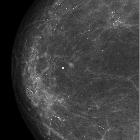Mastitis des Neugeborenen


Neonatal mastitis is rare and refers to infection of the breast tissue occurring in a neonate.
Clinical presentation
Patients may present with unilateral breast erythema and pain sometimes with associated nipple discharge and lymphadenopathy. It usually occurs in patients under five weeks of age, with a peak incidence around three weeks of age. Systemic symptoms, such as fever, are not always present.
Pathology
Neonatal breast hypertrophy is common in newborns that is thought to be from declining levels of maternal estrogen triggering neonatal prolactin secretion Infection of this breast tissue results in mastitis.
The most common causative organisms are Staphylococcus aureus (83-88% of cases), Escheria coli, Salmonella spp., anaerobes and Group B streptococcus.
Radiographic features
Ultrasound
- poorly defined hyperechoic breast tissue with hyperemia with surrounding hypervascular, hyperechoic subcutaneous fat
- abscesses may appear as avascular hyper or anechoic areas with surrounding hyperemia
Treatment and prognosis
Oral or parenteral antibiotic therapy is required. Breast abscess formation is the main complication from neonatal mastitis. Incision and drainage may also be necessary in cases of abscess formation.
Siehe auch:

 Assoziationen und Differentialdiagnosen zu Mastitis des Neugeborenen:
Assoziationen und Differentialdiagnosen zu Mastitis des Neugeborenen:

